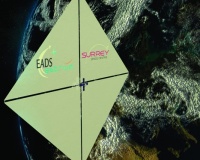
Funded by EADS Astrium, the Surrey team plans to launch the CubeSail mini-satellite in late 2011. When it reaches its orbit, it will deploy an ultra-lightweight sail measuring 25m2, which will increase the surface area of the spacecraft enough for drag to slow it down for safe de-orbit in low earth orbit (LEO).
According to Dr Vaios Lappas, senior lecturer of space vehicle control at Surrey Space Centre, future missions will demonstrate the ability of the sail to de-orbit spacecraft using solar-radiation pressure in orbits above 1,000km where there is no drag.
Approximately 9,400 objects orbiting Earth have been classified as junk, which equates to more than 5,500 tonnes of debris.
The build-up of debris is expected to grow by five per cent a year, creating serious hazards for space assets (The Engineer 22 February 2010).
The velocity, orbit and inclination of space debris define the impact of damage to such assets and altitudes containing ‘critical particle concentration’ exist near 800, 1,000 and 1,500km.
Measures have been taken to regulate the amount of time a space asset can remain aloft once its mission ends and debris mitigation guidelines include a 25-year de-orbit requirement from LEO.
For the mission in 2011, 3kg CubeSail will be based on a three unit (3U) CubeSat measuring 340 x 100 x 100mm. The 1U (100 x 100 x 100mm) section will be used for avionics, sensors and Attitude dynamics and control (ADCS). The remaining 2U will be used to house the Solar Sail deployment mechanism, which is key to the mission. It consists of a spindle containing the booms and the second one the folded membrane.
A scaled version of the deployment system has already been constructed to test different deployment configurations and folding patterns.
’We plan to conduct rigorous structural, vacuum/environmental, vibration testing to ensure the satellite will survive launch loads,’ said Dr Lappas.
If the one-year demonstration is successful, the de-orbiting system will be offered as standard for LEO satellites with a 500kg mass or less.
Active de-orbiting is anticipated in four years, which will involve docking an active nanosatellite with a sail onto non-co-operating debris.




Red Bull makes hydrogen fuel cell play with AVL
Formula 1 is an anachronistic anomaly where its only cutting edge is in engine development. The rules prohibit any real innovation and there would be...